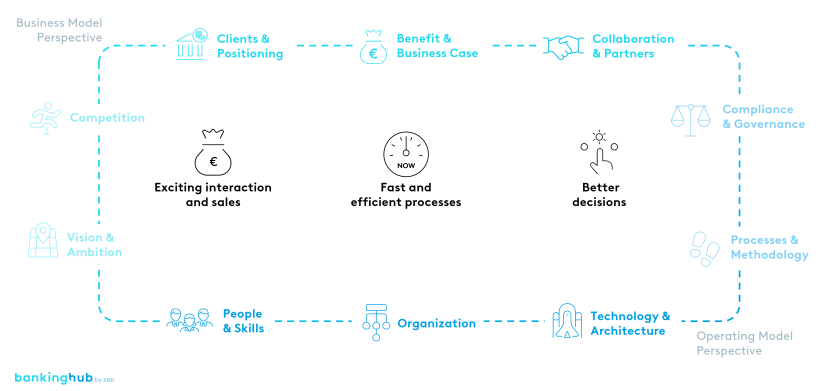Adding real value to the financial sector with AI applications
There is no doubt that data-driven technologies hold great potential for the financial industry. It is therefore important that financial institutions use these technologies in a targeted manner and in areas where they create demonstrable added value for the business. We can distinguish three areas of application for artificial intelligence and analytics in the financial industry.
Inspiring customers with the help of AI, strengthening differentiation through the use of analytics, increasing revenues
When interacting with customers, artificial intelligence technologies help create an enhanced customer experience through increased availability and shorter response times. At the same time, these technologies allow companies to focus on their core competencies and utilize resources more efficiently.
In this context, AI-based digital assistants are only in the early stages of development and will greatly change customer interaction in the coming years. These include solutions, such as chatbots or voicebots, whose specific aim is to make any interaction as personal and intuitive as possible.
Data analytics technologies help financial services providers to better understand their customers, to create value propositions that are more tailored to their needs, and consequently to achieve a positive effect on the company’s results. Customers should be offered the right product at the right time via the right channel with a personalized form of address.
Accelerating and streamlining processes in the financial industry with artificial intelligence
Banks and financial services providers must always distinguish themselves from the competition. The potential for efficiency gains through standardization at the customer interface or in the front office is therefore limited. In the middle and back office, however, processes can be implemented more efficiently and more leanly through intelligent automation. Artificial intelligence methods enable IT support for process steps, which previously were impossible to automate.
Thanks to AI, end customers benefit from significantly shorter response times and experience accelerated real-time service. Internal capacities are freed up for more complex and even more value-creating tasks, such as building and maintaining interpersonal relationships, thereby enabling further business growth.
Process mining analyzes the remaining manual processes of sales and production and evaluates them by applying data analytics methods. This approach provides an objective insight into the ongoing processes. The transparency thus created allows the institution to minimize risks and increase efficiencies.
Managing institutions more effectively with AI and making more informed decisions based on analytics
Making the right decisions requires decision-makers to take all relevant data and information into account. Growing data requirements in terms of quantity, structure, topicality and complexity increase the effort involved in data processing. At this point, conventional data analysis and evaluation methods soon reach their limits.
Innovative approaches from the data analytics and AI environment offer new possibilities for processing and evaluating the relevant data. They provide a data-driven basis to help the persons responsible make faster and better decisions.
BankingHub-Newsletter
Analyses, articles and interviews about trends & innovation in banking delivered right to your inbox every 2-3 weeks
"(Required)" indicates required fields
Meeting the requirements and framework conditions for the use of AI
In addition to the right choice of the AI application, financial services providers need to consider the necessary prerequisites and framework conditions to ensure that the use of data-driven technologies actually achieves the desired added value.
- This includes topics related to the technological and architectural setup,
- as well as less technical issues concerning the business
- and operating model.
I) Selecting the right technology and building a sound enterprise architecture
A specific prerequisite for the success of data-driven applications using artificial intelligence is the quality and effectiveness of the models developed. These in turn depend on the availability of trustworthy and up-to-date data, which are fed into them. To this end, a comprehensive data management system must be in place.
In addition to data, the realization of professional AI and data analytics applications depends on the choice of suitable, modern and future-proof data analysis tools and frameworks, as well as on the platform and infrastructure.
As we all know, the whole is greater than the sum of its parts. Therefore, aligning the necessary components and embedding them in the big picture within the enterprise architecture is of decisive importance to achieve a targeted implementation.
II) Correctly aligning the business model with AI and analytics
In principle, technology and the business model are closely interrelated. In the age of a “digital world”, the targeted deployment and use of technologies is not only supportive, but plays a decisive role in bringing the business model to life and in ensuring its long-term success.
Consequently, the use of modern technologies, such as artificial intelligence and data analytics, has long since become a strategic issue – in both directions: disruption as an external factor which both impacts and has a lasting influence on the business model.
At the same time, the alignment results in concrete requirements for application fields of “emerging technologies”. From this perspective, the correlation between technology and business model no longer simply means making something well-known better or more efficient, but goes one step further: opportunities and instruments are created to develop entirely new products or services or to address previously unreachable customer groups.
This interaction is consistently reflected in all relevant dimensions of the business model: from market and competition to products and services to monetization.
III) Effectively aligning operating model and governance to AI and analytics
The operating model faces the challenge of how to deliver the products and services defined in the business model to the customers. In the context of data-driven technologies, new requirements arise for people, process, organization and management.
Dealing with technologies, such as data analytics and artificial intelligence, requires new competencies and roles, such as data analyst, data engineer or data scientist. Another question that arises is how and where these new roles should be located in the organizational structure and how they should interact with the existing organization.
Furthermore, suitable processes and methods must be set up to effectively and efficiently carry out data-driven projects. The operating model must undoubtedly be realized in line with governance and compliance. Data-driven technologies have special requirements that need to be taken into account
Regardless of whether they are applications from areas such as customer interaction, processes or decision-making: it is of utmost importance to identify, evaluate and implement value-creating use cases for the application of AI and analytics in the financial sector. At the same time, a financial services provider should create the necessary framework conditions to ensure the project’s long-term success.































